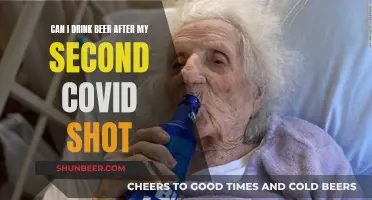
People with diabetes don't need to cut alcohol out of their diet. However, there are some important safety considerations. Alcohol competes with the liver's ability to produce glucose, which can lead to dangerously low blood sugar. Additionally, alcohol can cloud your judgement, so you may not realise your blood sugar is low. To prevent hypoglycaemia, don't drink on an empty stomach, and make sure to have food and water while drinking. It's also important to keep an eye on your blood sugar levels.
Beer is typically higher in carbs than other alcoholic drinks, but the carb content varies depending on the type of beer. Light beers have the fewest carbs, usually five grams or less per serving, and are also lower in alcohol content. Hoppy craft beers like IPAs and stouts tend to be much higher in carbs, with 15 grams or more per serving.
| Characteristics | Values |
|---|---|
| Alcohol consumption recommendations for people with diabetes | No more than one drink a day for women and up to two drinks a day for men |
| One drink | 12 fluid oz (360 milliliters) of regular beer (5% alcohol) |
| Carbohydrates in beer | 13 grams on average |
| Vitamins and minerals in beer | B vitamins, calcium, magnesium, phosphorus |
| Symptoms of low blood sugar | Feeling dizzy or lightheaded, loss of consciousness in more extreme cases |
| Safe alcohol consumption for people with diabetes | Drink in moderation, monitor blood sugar, and stay hydrated |
| Low-carb beer options | Miller Lite, Coors Light, Bud Light, Busch beers |
| Wine as an alternative to beer | Red wine: health benefits for people with diabetes, such as decreased oxidative stress, inflammation, and cardiovascular disease risk |
| White wine: comparable carb content to red wine | |
| Spirits as an alternative to beer | Gin, rum, vodka, or whiskey: 0 g of carbs per 1.5-oz (45-mL) serving |
What You'll Learn

Diabetics can drink alcohol, but in moderation
Diabetics can drink alcohol, but only in moderation. The recommended alcohol consumption for diabetics is the same as for the general population: no more than one drink per day for women and up to two drinks per day for men. One drink is defined as 12 fluid ounces of regular beer, 5 fluid ounces of wine, or 1.5 fluid ounces of 80-proof distilled spirits. It's important to note that drinking on an empty stomach can increase the risk of hypoglycemia, so it's advisable to consume alcohol with food. Additionally, drinking plenty of water and staying hydrated is crucial for regulating blood sugar levels.
Beer, a significant source of carbohydrates, can impact blood sugar levels. It can also be high in calories, contributing to weight gain over time. Some types of beer have higher alcohol content, which can further affect blood sugar. According to the American Diabetes Association (ADA), drinking alcohol can slow down carb metabolism as the liver prioritizes clearing alcohol from the body. This can lead to low blood sugar (hypoglycemia), especially when combined with diabetes medications. Therefore, it is essential to monitor blood sugar levels and be mindful of the amount and type of alcohol consumed.
When it comes to beer, "light" or low-carb beers are recommended for diabetics as they have fewer calories and carbohydrates. Popular options include Miller Lite, Coors Light, and Bud Light. These beers have significantly fewer carbs than their regular counterparts. For example, Miller Lite has 3.2 grams of carbohydrates in a 12-ounce serving, compared to 12 grams in regular Miller beers.
In addition to beer, diabetics can also consider other types of alcoholic beverages with low sugar or carb content. This includes red and white wines, distilled spirits such as gin, rum, vodka, or whiskey, and low-carb cocktails like martinis and vodka sodas. However, it is important to avoid mixing liquor with sugary juices or sugar-containing soda, as it can cause a spike in blood sugar levels.
While diabetics can enjoy alcoholic beverages, it is crucial to prioritize blood sugar management and overall health. This may include setting limits, monitoring blood sugar levels, and being mindful of the symptoms of hypoglycemia, such as dizziness, slurred speech, confusion, or sleepiness. It is also recommended to consult with a healthcare professional to understand how alcohol may interact with any medications and to discuss safe drinking practices.
Beer: A Mosquito Repellent?
You may want to see also

Alcohol can cause hypoglycaemia
Drinking alcohol can affect the liver's ability to regulate glucose levels, and it can also interact with certain medications, including insulin and diabetes drugs like sulfonylureas, to cause hypoglycaemia. This can occur several hours after drinking, so it's important to monitor blood sugar levels while drinking and for some time afterwards.
Symptoms of hypoglycaemia can include:
- Dizziness
- Lightheadedness
- Loss of consciousness
- Seizures
- Coma
These symptoms can be difficult to distinguish from those of intoxication, so it's important to test blood sugar levels if there is any doubt.
To prevent hypoglycaemia when drinking, it's recommended that people with diabetes:
- Don't drink on an empty stomach
- Limit alcohol consumption
- Drink slowly or moderately
- Monitor blood sugar levels closely
If symptoms of hypoglycaemia appear, it's important to take immediate action to raise blood sugar levels. This can be done by ingesting 15 grams of carbohydrates and then checking blood sugar levels again after 15 minutes. This process can be repeated until target levels are achieved.
Drinking Beer from Mason Jars: Is It Okay?
You may want to see also

Beer is high in carbs
Starch is one of beer's primary ingredients, and it typically contains 3–12 grams of carbs per 12-ounce (355-ml) serving. The carb content varies depending on whether it is a light or regular variety, with regular lagers typically containing 10 to 15 grams of carbs per pint, and some even exceeding 20 grams.
Light beers are a better option for those watching their carb intake, as they usually have less than 10 grams of carbs per pint, and some have less than 5 grams. For example, Miller Lite contains only 3.2 grams of carbohydrates in a standard 12-ounce serving, compared to 12 grams in regular Miller beers. Coors Light provides 5 grams of carbs per 12-ounce bottle, while a standard Coors Banquet has almost 12 grams. Bud Light provides fewer than 5 grams of carbs per serving, while a regular Budweiser has 10.6 grams. Busch beers are also a good option for people with diabetes, as most of their products have a low carb content. A 12-ounce serving of regular Busch contains just 7 grams of carbs, while Busch Ice and Busch Light have 4.2 and 3.2 grams, respectively.
Beer is not the only alcoholic drink that is high in carbs. Mixed drinks, for example, are also typically loaded with carbs due to ingredients like sugar, juice, and other high-carb mixers added to improve the flavor. Certain cocktails and mixed drinks can pack over 30 grams of carbs per serving.
When it comes to diabetes, it is important to note that while people with diabetes do not need to cut alcohol out of their diet completely, it is crucial to monitor blood sugar levels and drink in moderation. Alcohol can affect blood sugar levels and slow down carb metabolism, potentially leading to low blood sugar (hypoglycemia). It is recommended to have no more than one drink per hour and no more than three or four drinks per day for women and four drinks per day for men.
Beer Drinking Without Weight Gain: Is It Possible?
You may want to see also

Drinking alcohol can lead to weight gain
People with diabetes do not need to cut alcohol out of their diet. In fact, many studies have shown that light drinking (no more than one to two drinks a day) may be beneficial for people with diabetes. However, there are some important safety considerations to keep in mind. For instance, alcohol can affect your weight, and excessive alcohol consumption is the third leading cause of premature death in the United States. Here are some ways in which drinking alcohol can lead to weight gain:
Direct effect: excess energy
Alcohol is very calorie-dense, with 7 calories per gram, and it's easy to over-consume. Alcohol consumption within the government guidelines of up to 14 units per week for men and women can provide almost 3,000 extra calories per week if choosing the highest-calorie option. For heavy drinkers, this number is significantly higher.
Indirect effect: alcohol's tipping point
Alcohol has a 'tipping point' at which your inhibitions are significantly lowered, and your energy intake substantially increases over the following 48 hours. A recent research survey reported that the average tipping point is 9.3 units of alcohol, or roughly 3-4 drinks. After passing this tipping point, people tend to make poor food choices and increase their calorie intake by an estimated 4,305 calories that same evening. The day after, people tend to cancel planned physical activity and continue making poor food choices, leading to an additional 2,051 calories over two days.
Indirect effect: poor sleep quality
Drinking alcohol close to bedtime can impact the quality of your sleep, increasing your appetite and cravings for junk food while decreasing your energy expenditure the following day.
Other health considerations
Drinking alcohol can also affect your organs, particularly the liver, which plays a role in metabolising fats, carbohydrates, and proteins. Excessive alcohol consumption can lead to alcoholic fatty liver, which can damage your liver and affect the way your body metabolises and stores carbohydrates and fats. Alcohol can also negatively impact your digestion and nutrient uptake, as it causes stress on the stomach and intestines, leading to decreased digestive secretions and movement of food through the tract.
Beer-Induced Bowel Movements: Why the Rush to the Bathroom?
You may want to see also

Drinking alcohol can cause a hangover
People with diabetes do not need to abstain from alcohol entirely, but it is important to drink in moderation and to be mindful of how alcohol affects blood sugar levels. Beer is a staple beverage enjoyed all year round, but it is a significant source of carbohydrates, and so it can impact blood sugar. Beer can also be high in calories, and some types of beer have a higher alcohol content. The liver prioritises clearing alcohol from the body, so drinking alcohol can slow down the metabolism of carbohydrates, potentially leading to low blood sugar (hypoglycemia). This effect is exacerbated when drinking alcohol with diabetes medications. Therefore, it is important to be mindful when consuming beer and other alcoholic beverages when you have diabetes.
The causes of hangovers are not well understood, but researchers have found that alcohol can directly promote hangover symptoms through its effects on urine production, the gastrointestinal tract, blood sugar concentrations, sleep patterns, and biological rhythms. Alcohol is a diuretic, causing increased urinary output and dehydration. It also irritates the stomach and intestines, causing inflammation of the stomach lining (gastritis) and delayed stomach emptying, especially when beverages with a high alcohol concentration (>15%) are consumed. Alcohol increases gastric acid, pancreatic and intestinal secretions, and can lead to fatty liver, all of which can result in upper abdominal pain, nausea, and vomiting.
Alcohol also disrupts sleep and biological rhythms, including body temperature and the normal 24-hour (circadian) rhythm. Alcohol has sedative effects that can promote sleep onset, but the fatigue experienced during a hangover is due to disrupted sleep patterns, including decreased REM sleep and increased deep (slow-wave) sleep. Alcohol also relaxes the throat muscles, leading to increased snoring and possibly sleep apnea.
In addition to the direct effects of alcohol, hangovers may also be caused by the effects of alcohol withdrawal, the presence of congeners and other compounds in alcoholic beverages, the use of other drugs, and certain personal characteristics such as temperament, personality, and family history of alcoholism.
The Magic Behind Beer Filtration: Using Sheet Filters
You may want to see also
Frequently asked questions
Yes, people with diabetes can drink beer, but it is not without risks. Beer is a significant source of carbohydrates, so it can impact blood sugar levels. Beer is also high in calories, which can lead to weight gain. It is recommended that people with diabetes drink in moderation and only when their blood sugar levels are well-managed.
Drinking beer can cause blood sugar levels to drop too low, a condition known as hypoglycemia. This is because the liver, which is responsible for releasing glucose into the bloodstream, prioritises breaking down alcohol instead. Drinking beer can also affect the effectiveness of diabetes medications and increase weight gain.
Yes, there are some alternatives to beer that may be safer for people with diabetes to drink. These include drinks with fewer carbohydrates, such as light beers, dry wines, distilled spirits like gin and vodka, and low-carb cocktails.
People with diabetes should take several precautions when drinking beer, including drinking in moderation, drinking with food, monitoring blood sugar levels, and wearing a medical alert to indicate their diabetes. It is also important to avoid drinking if blood sugar levels are already low or if trying to lose weight.







